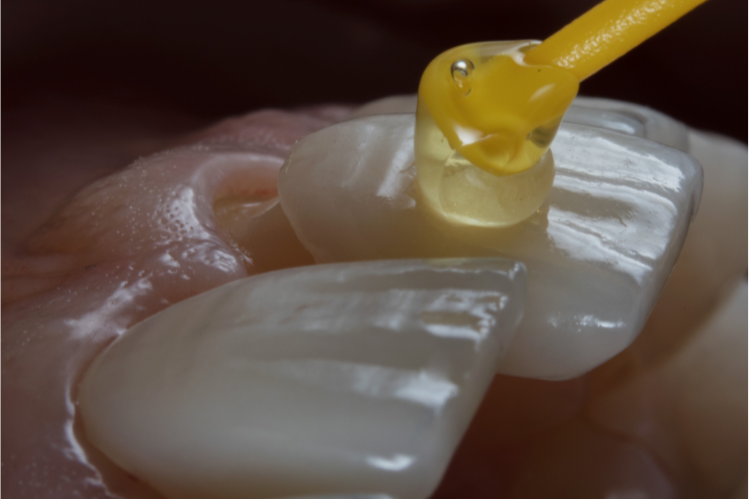
Table des matières
- Pourquoi les dents deviennent-elles grises ?
- Les facettes dentaires peuvent-elles masquer les dents grises ?
- Facettes dentaires ou blanchiment des dents : quelle solution est la plus efficace ?
- Autres options cosmétiques pour les dents grises
- Éléments à prendre en compte avant la pose de facettes dentaires
- Aligneurs transparents ou facettes dentaires : quelle est la meilleure option ?
- Alors, les facettes dentaires sont-elles faites pour vous ?
- FAQ
Votre sourire est l'une des premières choses que les gens remarquent. Et si vous avez les dents grises, cela peut vous faire perdre confiance en vous. Ce type de coloration dentaire est tenace. Les traitements de blanchiment réguliers sont souvent inefficaces. C'est pourquoi beaucoup de gens Pensez aux facettes dentaires pour les dents grises . Elles peuvent redonner de l'éclat à votre sourire et vous donner un aspect naturel. sourire.
Dans cet article, nous verrons si les facettes dentaires permettent réellement de masquer les dents grises. Nous examinerons également les causes de cette décoloration. Cela arrive. De plus, nous vous présenterons d'autres solutions contre la coloration dentaire que vous pourrez aborder avec votre dentiste.
Pourquoi les dents deviennent-elles grises ?
Pour comprendre comment les facettes dentaires sont utiles, il est important de savoir pourquoi les dents changent de couleur. Les taches jaunes proviennent souvent des aliments. La consommation de boissons ou certaines habitudes de vie, comme le tabagisme, peuvent être en cause. Cependant, une coloration grise indique généralement un problème plus profond.
Voici les causes les plus fréquentes :
- Coloration intrinsèque – Colorations à l'intérieur même de la structure de la dent. Elles sont souvent dues à des médicaments. comme la tétracycline.
- Nerf dentaire mort ou endommagé – Un traumatisme ou un traitement de canal peut donner à la dent une apparence foncée. ou gris.
- Émail aminci – Lorsque l'émail s'use, la dentine plus foncée sous-jacente devient plus visible.
- Génétique et vieillissement – Certaines personnes ont naturellement des dents qui paraissent plus grises en vieillissant.
Contrairement aux taches superficielles, ces problèmes sont plus difficiles à traiter avec un dentifrice blanchissant ou un agent de blanchiment. C'est pourquoi Les solutions cosmétiques pour les dents grises visent souvent à les dissimuler, principalement grâce à l'utilisation de facettes.
Les facettes dentaires peuvent-elles masquer les dents grises ?

Oui, les facettes dentaires peuvent masquer les dents grises.
Les facettes dentaires sont de fines coquilles, généralement en porcelaine ou en résine composite, qui recouvrent la surface avant de votre dent. Grâce à leur teinte personnalisée, elles peuvent masquer complètement les décolorations, même lorsqu'elles sont légèrement foncées.
- Facettes en porcelaine – Très résistantes, anti-taches et excellentes pour masquer les taches tenaces. Elles sont souvent privilégiées en cas de décoloration sévère.
- Facettes composites – Moins chères et plus rapides à poser, mais elles peuvent ne pas couvrir les gris très foncés. des teintes aussi efficacement que la porcelaine.
Alors, si vous vous demandez : « Les facettes dentaires peuvent-elles masquer les dents grises ? », la réponse est oui. Surtout celles en porcelaine. offrent généralement les résultats les plus naturels et les plus fiables.
Facettes dentaires ou blanchiment des dents : quelle solution est la plus efficace ?
Quand on veut corriger des dents jaunies, le blanchiment est souvent la première solution envisagée. C'est rapide, courant et efficace. Dans de nombreux cas, le blanchiment peut éliminer les taches de café, de thé ou de tabac. Il s'agit de taches superficielles, faciles à enlever. atteindre.
Mais toutes les taches ne sont pas identiques. Comme nous l'avons vu précédemment, les taches intrinsèques se situent à l'intérieur de la dent, et non à sa surface. surface. De ce fait, les gels blanchissants ne peuvent pas les atteindre. Quel que soit le nombre de séances effectuées, la couleur risque de persister. C'est la même chose. C'est pourquoi le blanchiment ne suffit pas toujours à corriger la coloration des dents.
Voici un résumé :
- Blanchiment : Excellent pour les taches jaunes en surface. Effet limité sur les taches grises ou internes.
- Facettes dentaires : Elles masquent les imperfections dentaires intrinsèques et extrinsèques, redessinant ainsi votre sourire. temps.
C’est pourquoi de nombreux dentistes recommandent les facettes plutôt que le blanchiment pour les taches lorsqu’il s’agit de dents foncées et tenaces. décoloration.
Autres options cosmétiques pour les dents grises
Bien que les facettes dentaires soient l'une des solutions les plus efficaces pour corriger la coloration des dents , elles ne sont pas les seules. option. Selon votre situation, votre dentiste peut vous suggérer :
- Blanchiment interne – Utilisé après un traitement de canal pour blanchir la dent de l'intérieur vers l'extérieur.
- Collage dentaire – Une résine de la couleur de la dent appliquée pour masquer les petites taches ou imperfections.
- Les couronnes recouvrent la totalité de la dent et peuvent être préférables pour les dents très fragilisées.
Votre dentiste évaluera la cause de la coloration grise de vos dents avant de vous recommander la solution la plus appropriée.
Avantages des facettes dentaires pour les dents grises (H2)
Les facettes dentaires masquent parfaitement les dents grises. Nous l'avons déjà expliqué. Cependant, leur fonctionnement présente certains avantages que vous ignorez peut-être. Vous trouverez ces informations ailleurs. Voici donc les avantages des facettes dentaires pour les dents grises :
- Résultats instantanés. Les facettes dentaires ne vous font pas attendre. Le changement est visible dès leur pose. Vous sortez du cabinet du dentiste avec un nouveau sourire.
- Choix de teinte personnalisée. Chaque dentition est unique. Certaines personnes recherchent un blanc éclatant. D'autres préfèrent un rendu plus doux et naturel. Les placages peuvent être réalisés sur mesure pour correspondre exactement à vos souhaits.
- Durabilité. Les facettes dentaires sont fines, mais résistantes. Les facettes en porcelaine , en particulier, peuvent durer de 10 à 15 ans. Soit plus d'une décennie. Profitez de votre sourire. Bien sûr, il est toujours important d'en prendre soin. Un brossage régulier, l'utilisation de fil dentaire et des visites de contrôle régulières vous permettront de garder de belles dents. les mettre en pleine forme.
- Solution complète. Les facettes ne se contentent pas de corriger la couleur. Elles font plus. Elles masquent les éclats. Elles permettent de lisser les irrégularités de la forme des dents. Elles peuvent même combler les petits espaces entre les dents. C'est pourquoi les facettes dentaires sont souvent utilisées. appelé « relooking du sourire ».
Pour beaucoup, les facettes dentaires s'avèrent être le choix le plus pratique. Elles résolvent plusieurs problèmes à la fois. Et plus encore. Plus important encore, elles vous redonnent confiance à chaque fois que vous souriez.
Éléments à prendre en compte avant la pose de facettes dentaires
Bien que les facettes dentaires puissent changer une vie, il est important de garder quelques points à l'esprit :
- Irréversible – Une petite quantité d'émail doit être enlevée pour une bonne adhérence.
- Coût – Les facettes dentaires sont plus chères que le blanchiment ou le collage, leur prix variant de 800 $ à 2 500 $ par séance. dent.
- Entretien – Ils nécessitent une bonne hygiène bucco-dentaire et des visites régulières chez le dentiste pour durer longtemps.
- Pas pour tout le monde – Si vos dents sont gravement endommagées, une couronne peut être une meilleure solution.
Aligneurs transparents ou facettes dentaires : quelle est la meilleure option ?
On entend souvent le débat entre les aligneurs transparents et les facettes dentaires , et l'on se demande quelle option est la meilleure. Le meilleur. Mais voici pourquoi la comparaison est erronée.
Les facettes dentaires recouvrent simplement vos dents, masquant les taches et les dommages. Vous pouvez constater à quel point leurs fonctions sont différentes. Les aligneurs transparents, quant à eux, redressent les dents. Leur rôle est de déplacer progressivement les dents vers la position idéale. alignement.
Il n'y a donc en réalité rien à comparer. Leurs fonctions sont très différentes.
Alors, les facettes dentaires sont-elles faites pour vous ?
La meilleure façon de savoir si les facettes dentaires vous conviennent est de prendre rendez-vous pour une consultation avec votre dentiste. Il examinera votre dentition. Nous vous expliquerons la cause de votre décoloration et vous guiderons pour savoir si les facettes, le blanchiment, le collage ou les couronnes constituent la meilleure solution.
Si vous en avez assez de cacher votre sourire et que vous vous demandez : « Les facettes dentaires peuvent-elles masquer les dents grises ? », la réponse est oui. Ils peuvent le faire avec brio.
FAQ
1. Comment dissimuler une dent grise ?
Une dent grise peut être camouflée ; on peut opter pour un collage, un blanchiment ou une couronne. Mais les facettes dentaires… sont souvent la meilleure solution. Elles recouvrent entièrement la dent et masquent sa couleur grise.
2. Pourquoi les dentistes déconseillent-ils les facettes dentaires ?
Parfois, les dents sont trop fragiles ou abîmées. Les facettes dentaires nécessitent un émail sain pour adhérer. Si vous Si vous grincez beaucoup de dents, elles risquent de ne pas durer.
3. Une facette peut-elle recouvrir une dent foncée ?
Oui. Les facettes en porcelaine sont conçues pour cela. Elles masquent même les teintes foncées ou grises.
4. Que se passe-t-il après 20 ans avec les facettes dentaires ?
Les facettes dentaires ne sont pas éternelles. La plupart durent de 10 à 15 ans. Après 20 ans, il faudra peut-être les remplacer.
Citations :
Académie américaine de dentisterie esthétique. Facettes en porcelaine https://yoursmilebecomesyou.com/procedures/cosmetic-dentistry/porcelain-veneers-usa
Association dentaire américaine. Facettes dentaires https://www.mouthhealthy.org/en/az-topics/v/veneers




